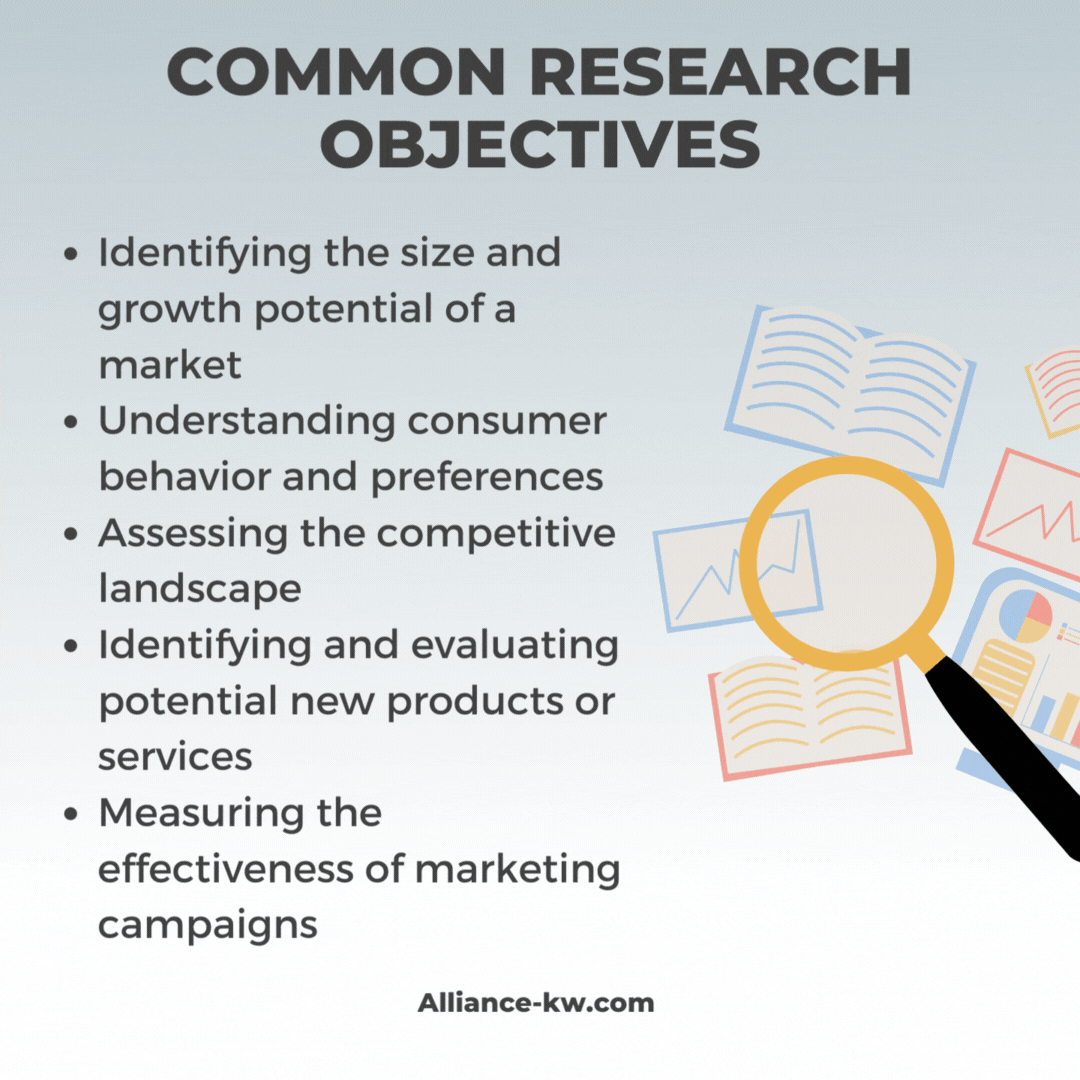
Are you looking to gain a competitive edge in the constantly evolving business landscape of 2023? Then, market research is your secret weapon.
It’s crucial for gaining valuable insights into your target audience and understanding the market trends that will shape the success of your business.
Keep reading to discover the top 11 strategies for effective market research and drive your business forward in 2023.

Market research is a process of gathering and analyzing information about customers, competitors, and the market environment to help inform business decisions.
It involves collecting data through surveys, focus groups, interviews, and other methods to gain insights into consumer behavior, market trends, and competitive strategies.
Here are the top eleven strategies for conducting market research to help you stay ahead of the game:
Research objectives serve as a roadmap for the research process, guiding the research design, methods, and data analysis development. Without clearly defined objectives, a business research project may lack direction and fail to provide meaningful insights.
For example, there’s a business interested in understanding consumer behavior. Without a specific research objective, it would be challenging for them to know what questions to ask.
Another benefit of clearly defined research objectives is that they help to ensure that the research project is aligned with the business’s strategic goals and objectives.
For example, a business may have a strategic objective to increase market share in a specific industry or geographic region. A research objective such as “to identify the size and growth potential of the target market” would be aligned with this strategic goal.
The insights gained from the research would be directly applicable to the business’s efforts to increase market share.

By having well-defined research objectives, businesses can gain valuable insights and drive business success.
A target market refers to a specific group of consumers most likely to purchase your products or services. By identifying and understanding your target market, you can effectively tailor your marketing efforts to reach and engage with potential customers.
Here are a few ways to segment a target market:
It involves dividing the market into groups based on characteristics such as age, gender, income, education, and occupation. For example, a high-end clothing brand targeting young professionals may segment its market by targeting consumers between the ages of 25-35 with a median income of $20,000 or higher.
It involves dividing the market into groups based on their lifestyle, values, personality, and interests. For example, a health food brand targeting individuals interested in organic and sustainable products may segment its market by targeting consumers who prioritize health and wellness in their daily lives.
It involves dividing the market into groups based on location, such as region, city, or neighborhood. For example, a home builder targeting retirees may segment their market by targeting consumers in retirement communities or areas with a high concentration of retirees.
By segmenting the market, you can effectively tailor your marketing efforts to reach and engage with potential customers.
Research methods refer to the techniques and tools used to collect, analyze, and interpret data.
Here are two different types of research methods to consider:
It involves collecting numerical data and statistical analysis. This method measures and quantifies a specific population’s characteristics. The data collected is often numerical, such as age, income, or test scores. Examples of quantitative research methods include surveys, experiments, and observational studies.
This research seeks to understand and interpret human behavior, experiences, and social phenomena. This method involves collecting data that is not numerical, such as observing people’s behavior, attitudes, and thoughts.
Examples of qualitative research methods include ethnography, case studies, and focus groups.

Both qualitative and quantitative research methods have their strengths and limitations, and it’s essential to choose the one that best suits the research objective.
Primary data is information collected directly from the source rather than from secondary sources such as published reports or online databases.
This type of data is more reliable and accurate because it is collected by the researchers rather than filtered through other sources.
Several standard methods for collecting primary data include surveys, interviews, and focus groups.
For example, a company planning to launch a new product might survey to gather information about consumer preferences and buying habits. They might also interview industry experts to gather information about the competitive landscape. And they might use focus groups to get feedback on a prototype of the new product.
In summary, gathering primary data gives access to unbiased, first-hand information, which is best for making informed decisions about the target market, industry, and competitors.
Analyzing secondary data allows businesses to understand their industry and market. In addition, by utilizing existing data, businesses can save time and resources compared to collecting primary data from scratch.
Several familiar secondary data sources for market research include:
Overall, secondary data analysis is an essential aspect of market research, providing businesses with a cost-effective and efficient way to gain valuable insights about their industry and target markets.
A thorough competitive analysis can also help businesses to identify potential opportunities and threats in the market and to make informed decisions about product development and pricing.
Businesses should follow these guidelines:
Online tools and resources have become increasingly popular in market research due to their cost-effectiveness, convenience, and ability to reach a broad audience.
Some of the benefits of using online tools and resources include the following:
Some popular online tools and resources include:
Using these tools, businesses can gain valuable insights into customer opinions and preferences based on current market trends.
Testing a product or service before launching it is essential for several reasons.
When conducting product or service testing, it is vital to keep the following guidelines in mind:
Gathering customer feedback is a crucial aspect of market research as it allows businesses to understand their customers’ needs, preferences, and overall satisfaction with their products or services.
This information can then be used to improve the customer experience, increase sales, and ultimately drive business growth.

There are several common ways to gather customer feedback, including:
Staying up-to-date on industry trends allows for the identification of new opportunities, as well as the identification of potential threats to a business. Knowing the current trends in the industry can also inform strategic decision-making and planning.
Here are several resources available for finding information on industry trends.
To stay up-to-date on industry trends, it is also important to monitor relevant government websites and agencies, as they may provide data and analysis on the industry.
Being open to unexpected findings during market research allows businesses to uncover new insights and opportunities they may have missed.
In addition, these findings can be valuable in a variety of ways, including:
Unexpected findings can reveal previously undiscovered segments of the market that a business can target with its products or services. For example, a company specializing in organic food products may discover a new market segment of health-conscious consumers looking for gluten-free options.
It can also provide businesses with valuable insights into improving their existing products or services. For example, a company that sells skincare products may discover that its customers are looking for more natural and organic ingredients, leading to new products.
It can also reveal new revenue streams for businesses. For example, a company specializing in outdoor gear may discover a significant demand for rental equipment, which can lead to a new rental service.
It may also reveal new marketing strategies a business can use to reach its target market. For example, a company selling clothing may discover that its target market is highly active on social media, leading to a new marketing strategy.
Therefore, businesses should approach market research with an open mind and be prepared to adapt their strategies based on the insights they uncover.
By implementing the top 11 strategies for conducting successful market research in 2023, you can gain valuable insights into your target audience and make informed business decisions. Take action today and conduct market research to stay ahead of the competition.
We would love to hear about your experience with these strategies and any additional tips you have for successful market research in the comments below.